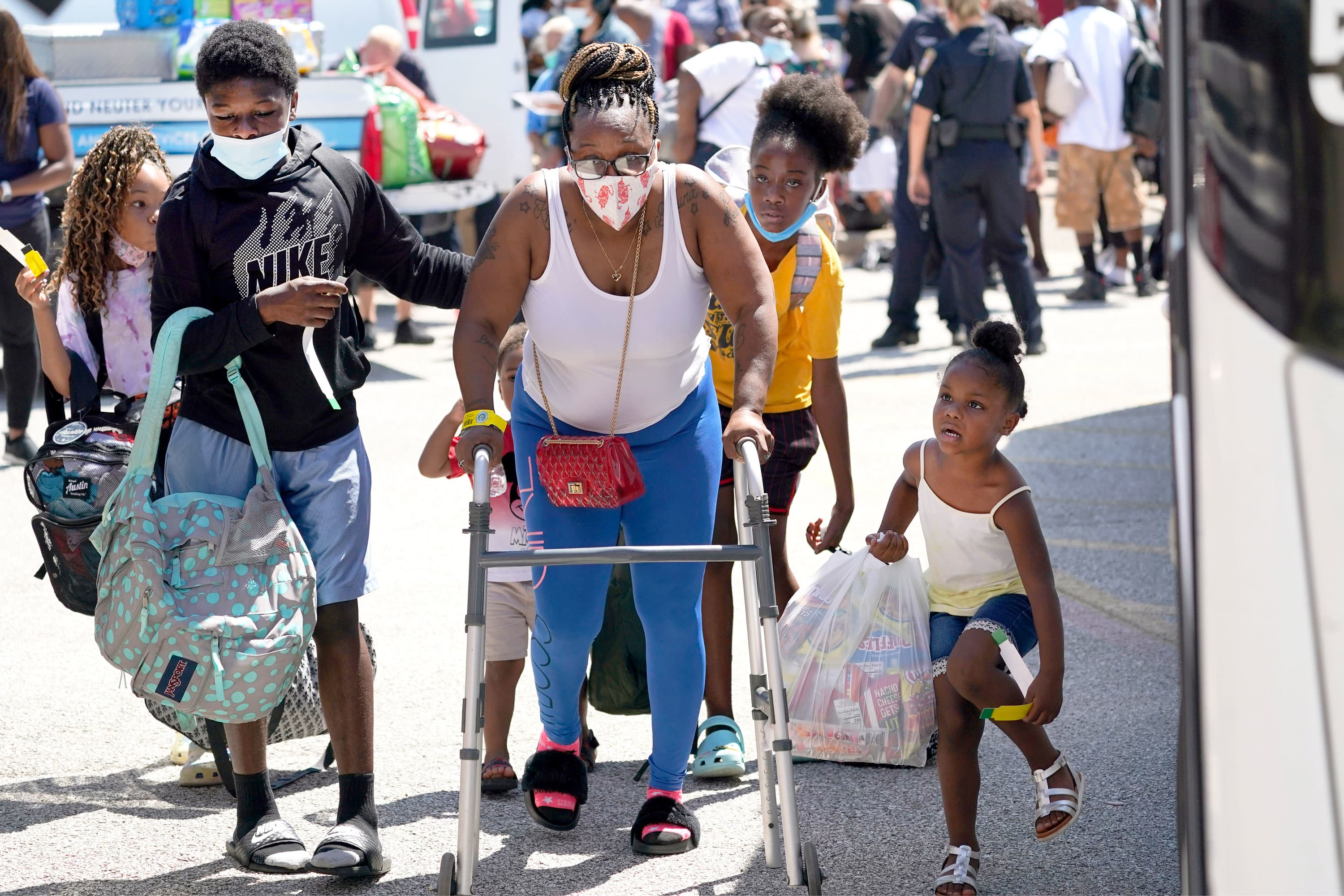
Evacuees walk to board buses Tuesday, Aug. 25, 2020, in Galveston, Texas. The evacuees are being taken to Austin, Texas, as Hurricane Laura heads toward the Gulf Coast.
David J. Phillip | AP
The coronavirus pandemic has thrown a new twist on emergency preparedness in Texas as officials prepare for Hurricane Laura to make landfall as soon as Wednesday.
The state is trying to evacuate residents in high-risk areas in a socially distanced manner, Gov. Greg Abbott said at a news briefing on Tuesday. Officials are encouraging evacuees to head for hotels where they can self-isolate instead of potentially crowded evacuation centers. The state is also providing protective equipment, such as masks, as well as Covid-19 testing services at shelter locations.
“We are responding to Hurricane Laura while also responding to a pandemic,” Abbott said. “And we are not taking our eye off of what needs to be done to adequately respond to the pandemic, so several things are being done as we assist those who are evacuating that’s different from what has been done in the past.”
Hundreds of thousands of Texas residents have been instructed to evacuate the cities of Galveston and Port Arthur, Abbott said, as well as Jasper, Jefferson, Newton and Orange counties. Still others were told to flee in parts of southwestern Louisiana, which is also expected to be struck by the hurricane. Abbott said more evacuation notices could come.
The storm is projected to become a Category 3 hurricane before it makes landfall, Abbott said, adding that “it could increase to be a Category 4 hurricane.”
He said officials are taking steps to prevent the spread of Covid-19 among evacuees during the storm. The coronavirus spread rapidly throughout Texas, especially the Houston area, earlier this summer. It has infected more than 580,300 people and killed at least 11,300 people in the state, according to the state’s department of health.
But the state has made substantial progress in bringing the outbreak under control with newly diagnosed cases per day down from an average of about 10,400 on July 22 to about 5,500, according to data compiled by Johns Hopkins University.
“Bottom line is this, and that is the state and local governments are fully aware that they are dealing with a pandemic while they’re responding to Hurricane Laura, and they’re taking all necessary protocols to make sure that they reduce the spread of Covid-19,” he said. “Just because a hurricane is coming to Texas does not mean Covid-19 either has or is going to leave Texas. Covid-19 is going to be in Texas throughout the course of the hurricane.”
Abbott said the state has 200 buses with another 200 ordered that will be used to assist evacuees, adding that the state ordered “so many buses” so that evacuees can appropriately distance from one another. Nim Kidd, chief of the Texas Division of Emergency Management, added that the buses will be equipped with disinfectant equipment.
Kidd added that protective equipment and Covid-19 testing teams will be sent to sheltering locations “as soon as practical.” He said, however, that staying in a hotel or motel room is the “safest place for families to be.”
When Hurricane Isaias brushed the coast of Florida earlier this month, the state suspended Covid-19 testing in some communities, said Cindy Prins, an epidemiologist at the University of Florida. She said that meant reduced monitoring of the virus in some communities and the state struggled to ramp testing back up to pre-hurricane levels.
She added that when people are evacuating from a hurricane, people are thinking about “their critical needs and not necessarily going to have Covid foremost in your mind.”
“We worry, of course, about people evacuating into group settings, trying to keep them safe if they’re having to go to a shelter,” she said. “I know that there’s been a lot of time to encourage people to go to hotels instead, but that’s not always very easy or feasible.”
Hurricane Laura is the second hurricane to strike Texas since the coronavirus pandemic began. Hurricane Hanna made landfall in South Texas as a Category 1 hurricane in late July. Catherine Troisi, an infectious disease epidemiologist at UTHealth School of Public Health in Houston, said Laura is likely to cause some disruption to the state’s coronavirus response, such as a drop in testing that can mask where the virus was spreading.
“Part of the drop in testing that we saw a couple of weeks ago may have been due to Hurricane Hanna,” she said. “That is a big concern about testing now.”
Beyond keeping testing efforts strong, she said, sheltering people safely from the storm and from Covid presents a major challenge for state officials.
“If you have to shelter people, how do you keep them safe during a pandemic?” she asked. “It’s enough of a challenge in regular times.”
